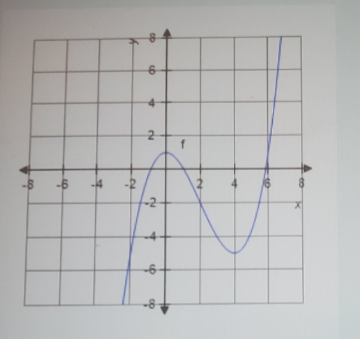Calculus: Early Transcendentals
8th Edition
ISBN:9781285741550
Author:James Stewart
Publisher:James Stewart
Chapter1: Functions And Models
Section: Chapter Questions
Problem 1RCC: (a) What is a function? What are its domain and range? (b) What is the graph of a function? (c) How...
Related questions
Question
![The image contains a problem related to calculus and graph analysis. The text reads:
"The graph of \( f \) is shown below. On what interval is \( f' \) an increasing function?"
A graph is provided which represents a function \( f \). The graph is plotted on a coordinate plane. The x-axis ranges from -8 to 8, and the y-axis ranges from -8 to 8. The curve appears to dip and rise, intersecting the x-axis at two points approximately near -1 and 5. The function decreases initially, forms a minimum, and then increases as it moves rightwards.
Below the graph is a multiple-choice question asking to select the interval where the derivative of \( f \), denoted as \( f' \), is increasing. The options given are:
a. \( (2, \infty) \)
b. \( (0, \infty) \)
c. \( (-1, \infty) \)
d. \( (1, \infty) \) [This option is marked "Incorrect"]
e. \( (-2, \infty) \)
The correct interval is not indicated in the image.](/v2/_next/image?url=https%3A%2F%2Fcontent.bartleby.com%2Fqna-images%2Fquestion%2Fa89fcfbc-9661-4037-a401-8de41697cbc3%2F57a4659c-0c45-4f20-903b-1e4f075b161d%2F35rm3b_processed.jpeg&w=3840&q=75)
Transcribed Image Text:The image contains a problem related to calculus and graph analysis. The text reads:
"The graph of \( f \) is shown below. On what interval is \( f' \) an increasing function?"
A graph is provided which represents a function \( f \). The graph is plotted on a coordinate plane. The x-axis ranges from -8 to 8, and the y-axis ranges from -8 to 8. The curve appears to dip and rise, intersecting the x-axis at two points approximately near -1 and 5. The function decreases initially, forms a minimum, and then increases as it moves rightwards.
Below the graph is a multiple-choice question asking to select the interval where the derivative of \( f \), denoted as \( f' \), is increasing. The options given are:
a. \( (2, \infty) \)
b. \( (0, \infty) \)
c. \( (-1, \infty) \)
d. \( (1, \infty) \) [This option is marked "Incorrect"]
e. \( (-2, \infty) \)
The correct interval is not indicated in the image.
Expert Solution
Step 1: We have given a graph

Step by step
Solved in 3 steps with 1 images

Recommended textbooks for you

Calculus: Early Transcendentals
Calculus
ISBN:
9781285741550
Author:
James Stewart
Publisher:
Cengage Learning

Thomas' Calculus (14th Edition)
Calculus
ISBN:
9780134438986
Author:
Joel R. Hass, Christopher E. Heil, Maurice D. Weir
Publisher:
PEARSON

Calculus: Early Transcendentals (3rd Edition)
Calculus
ISBN:
9780134763644
Author:
William L. Briggs, Lyle Cochran, Bernard Gillett, Eric Schulz
Publisher:
PEARSON

Calculus: Early Transcendentals
Calculus
ISBN:
9781285741550
Author:
James Stewart
Publisher:
Cengage Learning

Thomas' Calculus (14th Edition)
Calculus
ISBN:
9780134438986
Author:
Joel R. Hass, Christopher E. Heil, Maurice D. Weir
Publisher:
PEARSON

Calculus: Early Transcendentals (3rd Edition)
Calculus
ISBN:
9780134763644
Author:
William L. Briggs, Lyle Cochran, Bernard Gillett, Eric Schulz
Publisher:
PEARSON

Calculus: Early Transcendentals
Calculus
ISBN:
9781319050740
Author:
Jon Rogawski, Colin Adams, Robert Franzosa
Publisher:
W. H. Freeman


Calculus: Early Transcendental Functions
Calculus
ISBN:
9781337552516
Author:
Ron Larson, Bruce H. Edwards
Publisher:
Cengage Learning